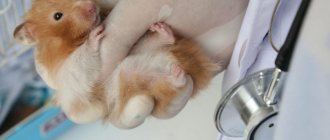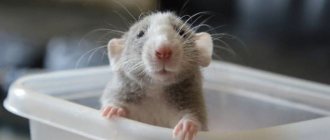Eye diseases
The eyes are a very vulnerable organ in hamsters.
Their convex black beads are easily subject to mechanical injury and infection. Conjunctivitis begins. A hamster can become infected not only by escaping from the cage, but even while in it if the owner forgets to clean the cage on time. The symptoms of conjunctivitis are easy to recognize. The animal’s eyes seem to become covered with a cloudy film, purulent discharge appears, the eyelids swell, become wet and stick together. The hamster begins to sleep a lot and loses its appetite. The animal's eyes become itchy and watery.
If such symptoms appear, you should consult a doctor. But you can also help your pet save his eyes on your own.
Treatment for eye inflammation
What to do if conjunctivitis begins?
Inflamed eyes in a hamster are almost always an infection. That's why:
- the patient must be immediately isolated from other animals;
- thoroughly clean the cage and disinfect the tray and all objects that are in the cage;
- we treat the infection with Albucid drops, 1-2 drops in the eyes at least 4 times a day;
- We support the hamster's diet - only a natural grain diet, to which you can add a little chicken to provide the patient with protein.
With this treatment, the hamster's eyes will be saved in 5 days.
Hair loss and other diseases of hamsters
Dandruff, scratching and baldness in hamsters can be caused by ectoparasites, pathogenic dermatophyte fungi, endocrine system disease, and sometimes tumors. The severity and duration of skin diseases in hamsters depends on the cause.
Many of these diseases, such as dermatophytosis or lichen in hamsters , are contagious and can be transmitted to humans. Therefore, if you notice suspicious symptoms, immediately take your hamster to a veterinarian.
Hamsters are often troubled by Demodex , which can be transmitted from one hamster to another. Only a veterinarian can identify the cause and prescribe the correct treatment.
Abscesses are an accumulation of pus in a limited cavity. Pus accumulates under the skin, sometimes forming large, painful swellings on the surface of the hamster's body. Abscesses can form due to cuts and scrapes in the skin. If sharp food particles injure the wall of the cheek pouch, a cheek pouch abscess may develop, and the cheek will appear full all the time. Abscesses require treatment by a veterinarian.
Lymphocytic choriomeningitis is a disease of viral etiology; it can be asymptomatic in hamsters, but there is a danger of infection in humans. When buying a hamster for a child, remember the possible risks; conduct a preventive examination of the animal by a veterinarian.
Other diseases
If your hamster is breathing frequently "out of the blue" without being scared or tired, this indicates respiratory or heart failure.
You need to listen to the breathing of a tiny animal - wheezing, gurgling, snuffling indicate problems with the lungs. If you've recently had a runny nose and your hamster has become lethargic and reluctant to eat, it could be pneumonia (pneumonia). The animal simply cannot breathe, so it tries not to move and freezes in one place.
Treatment consists of antibiotic therapy - for small rodents, Baytril 2.5% is traditionally used at a dose of 0.4 ml per 1 kg of weight (for a dzhungarik weighing 50 grams, this is 0.01 ml). Injections are given subcutaneously 1 time a day for 10-14 days.
If a hamster lies motionless with his eyes open and breathes heavily, and before that he was sick for several days, then he dies. There is no way to help a rodent in agony; even an experienced veterinarian can only end the suffering by euthanizing the animal.
Consider whether your hamster has wet tail fur (a sign of diarrhea), a sudden increase in abdominal contour, or sudden weight loss. Hamsters have a very fast metabolism, so they cannot be sick for a long time: without proper treatment or in case of severe problems, they “burn out” in a few days.
Decorative hamsters have fragile health, and yet the animal can live its entire short life without getting sick. To do this, you just need to follow simple feeding and maintenance rules. In case of unforeseen circumstances, you need to find out in advance where to go for an appointment with a rodent - general practitioners will not be able to provide qualified assistance. And do not despair if the hamster lies and does not move, but breathes: perhaps all is not lost.
The hamster lies motionless: reasons 4.8 (95%) 12 votes
Other diseases typical for pets
Often the reason that a hamster lies, does not move, does not eat, does not drink, but breathes, are infectious and viral diseases. In such cases, it is advisable to pay attention to additional signs, since in the absence of timely medical assistance, the hamster may die.
Pneumonia
Pneumonia, or “pneumonia,” can occur if the cage has been left in a draft or in a cool, humid room, such as a bathroom, for a long time. Additional signs of its development, in addition to frequent breathing, are:
- wheezing, gurgling in the lungs, which can be heard without additional equipment;
- presence of nasal discharge;
- lack of physical activity, lethargy;
- lack of appetite.
In such cases, it is best to call a ratologist, because the animal will need intensive injection therapy for 10-14 days. Only a specialist can prescribe medications. However, rapid breathing can cause heart failure. Upon examination, only a veterinarian will be able to indicate the real reason for this behavior.
Agony
If the hamster lies motionless, his eyes are open, and his breathing is heavy, he is most likely in his death throes. This often occurs after the animal falls ill a few days before the onset of such a condition. It’s a pity that if the hamster is breathing heavily and lying on his back, most likely there is no way to help him. An experienced veterinarian will suggest performing a euthanizing injection in such cases.
To make sure that the baby is really in agony, you need to remember whether he had diarrhea in the last 24 hours, whether his stomach suddenly increased in size and whether the pet lost weight. Hamsters cannot get sick for a long time because their metabolism is too fast. For this reason, you should immediately call a veterinarian or go to him for an appointment yourself, because hamsters “burn out” literally in a day or two.
Electric models
Beginners should pay attention to more innovative gadgets. They are definitely a little more expensive
But in this case, the price increase proportionally affects safety.
We are talking about a family of rechargeable machines equipped with a rotating head. They do not cut, but grind down the cornea. With this approach, it is almost impossible to harm a dog or cat by catching too much of a nail. The high rotation speed of the tip ensures fast operation, and the low noise level does not bother four-legged patients at all. Any beginner can easily cope with such a mechanism.
Price – 481 – 1,859 rubles.
Some models are equipped with 2-3 heads, suitable for dogs or cats of various breeds and age groups.
After all, the claws of a dwarf poodle are much more delicate than those of a German shepherd. The same applies to young kittens and adult cats - their paws need to be treated with different elements. So, when purchasing a tool for trimming claws, you should consider this nuance.
Cost – 567 – 1,189 rubles.
The final touch is the rotation speed of the device head.
It directly affects the quality of claw grinding. After all, it is necessary not only to cut off the ends, but also to polish the ends so that the sharp edges do not injure the delicate pads of the paws. This operation is best done in a more gentle mode at low speeds. So a machine with gear shifting will come in very handy in this case.
Price – 497 – 1,566 rubles.
I like it I don't like it
Increased ambient temperature
Small rodents, despite the fact that in the wild they can live in steppes, deserts and semi-deserts, do not tolerate heat well.
Prolonged exposure to high temperatures can lead to heat stroke.
Signs of this condition will be:
- Trembling when touched
- Convulsions
- Weakness and indifference
- Coordination of movements is impaired
- The hamster lies on its side and breathes heavily
Sudden overheating can lead to heart failure, which can be fatal. Such rodents do not have the body's natural protective functions in the form of sweat or mouth breathing.
If the animal is lethargic, but the exposure to high temperatures has not been for a long time, then the first aid will be to move it to a cooler room and spray cold water over it from a spray bottle.
A quick way to cool the body is to place the animal under a stream of cold water, holding the muzzle so that the hamster does not choke.
If the animal begins to come to life, it is important to give it water using a syringe or pipette
In an unconscious state, the rodent will not be able to swallow liquid. To replenish the water-salt balance, a solution of sodium chloride or ringer is injected subcutaneously. Large breeds can be injected from four to eight milliliters, dwarf and Djungarian hamsters - two milliliters.
In an emergency, when veterinary care cannot be obtained, prednisolone is injected intramuscularly into the hind leg using an insulin syringe.
For a Syrian hamster, the dose is 0.1 ml, for a Djungarian hamster - half as much.
Interesting video
Djungarian and Syrian hamsters are very cute, funny, unpretentious animals to keep and care for. Therefore, many people keep them as favorite pets. But unfortunately, the life expectancy of a hamster is short.
Even with proper maintenance and systematic care, the animals live from 1.5 to 2.5–3 years. At the same time, there are many factors that can accelerate the death of a small pet. And it’s not always possible to understand why hamsters die and how to help your pet. Why do hamsters die? How to understand that a dzhungarik is dying? What to do if your hamster dies?
How to bring a hamster back to life
Waking up a sleepyhead is not so easy
If for some reason the owners still decide to allow the rodent to go into a state of torpor, but now they would like to bring it back to life, they should be careful when waking up the hamster. So, for example, a sharp change in temperature can cause irreversible changes in his body
Therefore, you can try to warm up a cold hamster first in your hands, and then by wrapping it in a warm cloth. Gradually it is necessary to increase the temperature to a comfortable one. Resuscitation should produce results after a short period of time. Your heartbeat will become clearer, your breathing will become faster, and your body temperature will begin to rise. And eventually the rodent will open its eyes.
If the hamster's state is not sleep, but death, attempts to warm it up will be useless.
Video about hibernation in a hamster
Today we talked about torpor and hibernation in hamsters, why domestic hamsters still hibernate and how to wake up your rodent. We hope that our article will be useful to you.
Please also share with our readers your experience of keeping hamsters.
Agony
Due to old age or serious illness, the hamster falls into agony. He may not move for a long time, and then convulsions and depressed breathing occur. In this case, even an experienced specialist will not be able to reverse the animal’s condition.
Did you like the article? Share with friends: [supsystic-social-sharing id=”1"]
- Related Posts
- Hamster has a cold
- Hamster's eyes won't open
- Hamster going bald, causes, symptoms, prevention, treatment
« Previous entry
How to introduce a treat into the communication process
Adding a treat for the animal is the second step towards building trust. If the pet is already completely accustomed to your hand and is not afraid of it at all, you can safely move on to this step. To do this you will need a treat, it could be:
- seed;
- nut;
- a piece of fruit or vegetable;
- greenery.
You need to put a treat on your fingertips, lower your hand into the cage and carefully treat the animal.
Next, you can place a treat on your palm and invite the hamster to climb on it to take the treat. As a result, the animal will sit in your palm and calmly absorb the food offered.
At the moment when your pet sits on your hand and eats a treat, you can gently stroke it with your second hand. If the animal accepts your affection without fear, you can learn to take your pet in your arms
Simple wire cutters
The most primitive device is very similar to ordinary scissors. Only one of its cutting surfaces is equipped with a small notch with a sharp edge. Using such a device is easy, provided you have some skill and experience. For young dogs, nail trimming is always stressful. They do not want to sit quietly, they strive to tear the paw out of the owner’s hands and in every possible way complicate the process. So Litbro.ru will not recommend such a gadget to novice dog breeders. The risk of causing serious physical injury to your pet is too great. Well, for experienced owners who have used similar tools more than once, nothing better can be desired. Cheap and very effective.
Cost – 35 – 72 rubles.
More advanced versions of hand cutters offer expanded functionality.
Although their main part, in the old fashioned way, is based on two cutting surfaces. Service additions imply only human convenience. Models with rounded ends, a container for cut claws and lighting have proven themselves very well. The fact is that some dogs have the habit of looking for clipped ends on the floor and eating them. Sharp, bent cuttings can damage the stomach wall and cause bleeding. A small “waste collection” effectively solves this problem.
Price – 636 rub.
Another gadget from the line of simple nippers has comfortable ergonomic handles that allow you to securely hold the tool while trimming nails.
This is important when the animal gets nervous and breaks out.
We pay attention to one more detail - the expansion spring. It fixes the cutting surfaces in the open state, which makes the operation somewhat easier.
Otherwise, the functions of the device duplicate all the features of its predecessors. To properly shorten claws, you must have the skill and achieve unquestioning obedience from your dog or cat.
Cost – 229.93 rubles.
Temperature-related disorders
If a previously healthy animal suddenly falls into a coma, it is possible that it is hibernating. Breathing will be very rare, and the pet will be cold to the touch. In nature, dwarfs hibernate in winter, waiting out cold, hunger and short daylight hours.
Low room temperature
If the heating was turned off in the apartment, or you did not feed the hamster for several days while going on vacation, this could provoke torpor. The body will be cold, the heartbeat will be extremely rare (1 beat every 15 seconds). A sleeping hamster can barely breathe; due to its small size, it is difficult to understand whether there is breathing at all. But if the body remains soft, the rodent has not died. To awaken the animal, the cage is placed in a warm room (more than 20 C), the feeder and drinking bowl are filled. The hamster should wake up in 2-3 days.
Heat
The Djungarian hamster lives in the steppes, and the Syrian even in semi-deserts, but both species are extremely sensitive to high temperatures and direct sunlight. Tiny nocturnal rodents with dense fur have no protection from overheating - they do not sweat or breathe through their mouths like dogs. Heat stroke is deadly for them.
Signs of hyperthermia:
- the hamster does not move and is breathing heavily;
- weakness;
- convulsions;
- impaired coordination of movements.
In case of acute overheating, heart failure leads to the death of the pet. Death may not occur immediately, but within a couple of days due to the failure of all organs, if the temperature has risen so much that proteins have coagulated in the blood and organs (at 44 C).
Situations in which there is a danger of heat stroke:
- transportation in a car;
- a cage on a windowsill or balcony, outside (sun);
- near heating devices;
- in a stuffy room with high humidity.
It can be difficult to understand why a hamster is lying on its side and breathing heavily if by the time the owner returns the sun has already gone and does not illuminate the cage.
Treatment for heat or sunstroke
Transporting a pet to a clinic in case of heat or sunstroke is not the best solution; time for first aid will be missed. What can you do without the help of a veterinarian to help your pet:
Reduce temperature
First aid is to cool the body, but not too sharply: applying ice or immersing the hamster in water is prohibited! The animal is placed on a tile or ceramic dish, or on a damp towel
Gently moisten ears and paws with cool water.
Fighting dehydration
Heat stroke very often occurs when there is no access to fresh drinking water. When the animal is unconscious, it can no longer use the drinking bowl. However, it is also dangerous to drink a hamster from a syringe: it will not swallow, and the liquid will enter the lungs, making breathing difficult and causing pneumonia.
The liquid (sterile Ringer's solution or sodium chloride) is injected subcutaneously into 4-8 ml of Syrian and 2 ml of Djungarian hamsters.
Antishock therapy
Although all potent medications are best used as prescribed by a doctor, in a situation with acute overheating, the hamster may not survive to take the ratologist. If you feel like you have nothing to lose, you should inject prednisolone 30 mg/ml intramuscularly (in the hind leg) with an insulin syringe. The dose for a Dzhungarik is 0.05 ml, for a Syrian - 0.1 ml.
Whether your pet survives may depend on how long it was exposed to the high temperature. If the hamster does not die immediately, on the first day after overheating the owner often notices that the hamster falls over on its side and can barely walk. Neurological disorders are associated with swelling of the brain, and if the pet survives, coordination of movements will gradually be restored.
Signs of death in a hamster
It is possible to determine the approaching death of a pet by behavior and external changes.
Behavioral features
The animal becomes lethargic and apathetic. Does not want to communicate with its owners or other rodents. The animal does not show curiosity, does not strive to get out of the cage, and does not show interest in food. The rodent stops storing food because it feels that it will soon die and will no longer need food.
If a decrease in activity is observed during the cold season, make sure that the hamster is not hibernating. External signs are similar to the symptoms of a number of diseases and manifestations of old age.
External symptoms
It is possible to recognize approaching death by a number of external signs:
- Sudden weight loss. An animal that senses the approach of death ceases to be interested in food, which is why it quickly loses weight and loses adipose tissue.
- Dullness of the eyes. The organs of vision cease to shine and gradually become more and more cloudy.
- Condition of the coat. Hair becomes dull and thins. Several hairs may stick together to form “icicles.”
Animals behave differently. Some hamsters die quietly. Others begin to “cry”, gradually these sounds turn into wheezing.
Dull eyes and refusal to eat are some of the signs.
Statement of death
Unlike animals in a torpor, the dead do not breathe and have no pulse. To check, hold a mirror to the animal’s nose. If it fogs up a little, the hamster is still alive. The dead animal cools down within several hours. During torpor, body temperature decreases slightly.
Simple wire cutters
The most primitive device is very similar to ordinary scissors. Only one of its cutting surfaces is equipped with a small notch with a sharp edge. Using such a device is easy, provided you have some skill and experience. For young dogs, nail trimming is always stressful. They do not want to sit quietly, they strive to tear the paw out of the owner’s hands and in every possible way complicate the process. So Litbro.ru will not recommend such a gadget to novice dog breeders. The risk of causing serious physical injury to your pet is too great. Well, for experienced owners who have used similar tools more than once, nothing better can be desired. Cheap and very effective.
Cost – 35 – 72 rubles.
More advanced versions of hand cutters offer expanded functionality.
Although their main part, in the old fashioned way, is based on two cutting surfaces. Service additions imply only human convenience. Models with rounded ends, a container for cut claws and lighting have proven themselves very well. The fact is that some dogs have the habit of looking for clipped ends on the floor and eating them. Sharp, bent cuttings can damage the stomach wall and cause bleeding. A small “waste collection” effectively solves this problem.
Price – 636 rub.
Another gadget from the line of simple nippers has comfortable ergonomic handles that allow you to securely hold the tool while trimming nails.
This is important when the animal gets nervous and breaks out.
We pay attention to one more detail - the expansion spring. It fixes the cutting surfaces in the open state, which makes the operation somewhat easier.
Otherwise, the functions of the device duplicate all the features of its predecessors. To properly shorten claws, you must have the skill and achieve unquestioning obedience from your dog or cat.
Cost – 229.93 rubles.
Treatment of hyperventilation syndrome
Most patients with hyperventilation syndrome believe that they are suffering from a terrible fatal disease, which only makes the situation worse. Therefore, the first stage of treating the disease is to influence the patient on a subconscious level. Changing the patient's attitude towards his state of health, combined with the correction of psychogenic disorders, is the first step towards recovery.
The primary task of the doctor treating hyperventilation disease is to demonstrate to the patient the complete absence of organic changes, even despite the severity of the symptoms
It is important to prove the truth that it is simply impossible to die during a hyperventilation crisis, and also to demonstrate how the severity of the crisis state of the disease depends on internal tension. Sometimes this is enough to cope with the disease
And sometimes awareness of the safety of the disease and a changed attitude towards it are only half the way.
Breathing exercises that teach breathing with the diaphragm have proven themselves well. It allows you to learn how to breathe correctly and maintain the ideal proportion of inhalation and exhalation (1:2). At first, such exercises last 3-5 minutes until the body gets used to them. Over time, the duration of gymnastics increases.
Psychotherapeutic methods of treating hyperventilation syndrome stand apart. With the help of behavioral therapy, the method of suggestion, psychoanalysis and other methods of influencing the brain and subconscious, patients begin to look differently at the disease and its severity.
Hyperventilation syndrome is often treated using biofeedback. This method has proven itself well in medical practice. Its essence is to control body functions. In the case of hyperventilation syndrome – control of respiratory function.
It is important to change your lifestyle, as well as your rest and work schedule. It is necessary, if possible, to exclude night shifts and overtime, and sleep should be complete every day
Walking and moderate physical activity should become mandatory. It’s better to spend weekends in a new environment in nature: fishing, relaxing in the countryside, and so on. It is important to stabilize the psychological component of the body, so it is necessary to do what you love as often as possible, get rid of stressful situations and have proper rest.
The complex of drug treatment for hyperventilation syndrome consists of various drugs:
Vegetative agents: β - adrenergic blockers (Metoprolol, Anaprilin), Bellataminal, Belloid, Bellaspon, Platyfillin;
Drugs aimed at correcting psychological disorders: tranquilizers (Grandaxin, Gidazepan, Afobazol, Adaptol and others), antidepressants (Cymbalta, Amitriptyline, Sirlift, Prozac, Coaxil and so on), antipsychotics (Ridazine, Eglonil), sedatives (Corvalol, Persen, Dormiplant, valerian tincture and others);
Metabolic drugs (Actovegin, Riboxin, Mildronate and others), B vitamins (Neurobeks, Milgamma);
Drugs that reduce muscle-nervous excitability: products with magnesium (Magne B6), calcium (Calcium Chloride, Calcium Gluconate), vitamin D2.
In the treatment of hyperventilation syndrome, drugs necessary for use during a crisis are also used (Anaprilin, Platyfillin). They help alleviate the patient’s condition and cope with symptoms. A simple method will also help you overcome the crisis: you need to continuously breathe into a plastic bag. You can't take your face off of him. As a result of such breathing, more carbon dioxide will accumulate in the bag, which helps to overcome the crisis of hyperventilation syndrome.
The course of drug treatment for hyperventilation syndrome usually lasts more than 2 months. However, the list of medications and the treatment plan must be drawn up by the doctor individually for each patient, depending on the symptoms, the severity of their course, the stage of advanced disease, the characteristics of the body, drug intolerance, and so on.
Hyperventilation syndrome certainly spoils life and significantly reduces its quality. Despite the severity of the symptoms, the disease is not fatal. And for a successful recovery, the patient must understand this truth. And in order to finally cope with the disease, the intervention of experienced specialists in the field of psychology (psychotherapy) and neurology is necessary.
Causes caused by incorrect temperature conditions
In order to understand whether the hamster is really sick if he does not move but breathes, it is worth performing a detailed examination
Attention should be drawn to the baby's eyes, breathing rate, and the naturalness of his posture. If your pet is breathing calmly and steadily with his eyes closed, it is most likely that he is just sleeping.
Heatstroke
It is known that individuals of the order of the hamster family, without exception, cannot tolerate heat or direct sunlight. Oddly enough, nature has deprived them of a system of protection against overheating; pets never sweat or breathe through their mouths like dogs. There are known cases where heat stroke resulted in death for animals.
To understand that your baby is overheated when he lies on his side and breathes heavily, you should pay attention to the presence of such signs as:
- no attempt to roll over or make any movements;
- lethargy;
- presence of seizures;
- impaired coordination of movements.
The likelihood of heatstroke occurring when your hamster is motionless and panting increases under the following conditions:
- improper transportation of the baby in personal transport;
- installing the cage on a balcony, window sill, in a place exposed to direct sunlight;
- installing the cage near heating devices;
- with high room humidity and stuffiness.
If you don’t immediately help your pet when he doesn’t move but is breathing, he may not be saved. For this reason, it is worth providing first aid to the animal, which is to:
- cool his body temperature - put the baby on a damp towel, tile, moisten his ears and paws with cool water. Do not rub frozen ice cubes or place them in water;
- inject subcutaneously 2 ml of water that the animal usually drinks to prevent dehydration;
- carry out anti-shock therapy - without waiting for the doctor, this should not be done. But if the ratologist is delayed, and the pet is getting worse, he can be given an injection in the hind leg (intramuscularly) of prednisolone 30 mg/ml with a syringe intended for administering insulin. The dose for a Syrian will be 0.1 ml, and for a Djungarian - 0.5 ml.
"Coma" or hibernation
If the hamster lies without moving, it is possible that the pet has fallen into a kind of coma, that is, into hibernation. His breathing remains calm and even, and his skin will be somewhat cool. In the wild, hibernation of individuals of the hamster order usually occurs in the winter season, when they need to survive cold, hunger, and decreased daylight hours.
The causes of “coma” can be the lack of food for several days in the absence of its strategic reserves, a heating shutdown or a sharp cold snap, which makes the apartment cool. The main signs that the baby is hibernating will be:
- closed eyes while breathing;
- cold but soft to the touch body;
- slow heartbeat (no more than a beat every 15 seconds).
In such cases, it is recommended to place the animal’s cage in a room where the temperature is equal to or above 20°C, and fill its feeder and drinking bowl. Within a few days, if all is well, the animal usually wakes up. If, after emerging from hibernation, he has impaired coordination of movement, which does not go away, he begins to sneeze, cough, or develops diarrhea, as evidenced by a wet tail, you should consult a veterinarian. And since it is undesirable to transport the baby after waking up from hibernation, it is better if he arrives on his own.
Main causes of heavy breathing
The animal's condition can worsen due to various reasons:
- Pneumonia is the development of inflammatory processes in the lungs. Characterized by wheezing, gurgling and wheezing sounds when breathing. An indicator of the disease is also discharge from the nasal cavity observed over several days. In this case, the hamster becomes inactive, inactive, does not approach the feeder, and drinks little. It becomes difficult for him to breathe, which hinders his movements. The animal simply lies and tries to move less.
- Tumors or metastases in the lungs. Tumors can be benign or malignant (cancerous). Catalysts for their formation can be viruses, a previous infectious disease, decreased immunity, disturbances in the hormonal system, injuries and other reasons. If the tumor begins to spread throughout the body, metastases appear. Their localization may also be in the lungs.
- Poisoning. Intoxication factors: spoiled food or low quality water; eating poisonous plants or grains; ingress of toxic substances into food or water. Signs of poisoning include difficulty breathing, thirst, lethargy, refusal to eat, vomiting, and diarrhea.
- State of agony. If the hamster is breathing heavily and does not move, then this may be an indicator of the pre-mortem stage. Occurs as a result of a serious illness.
Related article: Hamster bleeding from anus (under tail)
Heatstroke
I would like to highlight heat stroke in hamsters as a separate point. They are very susceptible to high temperatures and open sun. This is due to the lack of protection against overheating. Signs of heat (sun)stroke:
- the hamster breathes heavily through his mouth;
- the animal looks weakened;
- convulsive syndrome may appear;
- movements become uncoordinated.
With severe overheating, heart failure develops, which leads to death. It can occur either instantly or after a few days, when all organs gradually fail. Heat stroke occurs in the following situations:
- transporting a pet by road during the hot season;
- placing the cage near a window or on a balcony, as well as near radiators or heating devices;
- non-compliance with the optimal microclimate (high temperature and humidity in the room).
In some cases, it is difficult for the owner to understand why his pet is breathing heavily and hardly moving. For example, if he noticed this when the sun was no longer there, or it stopped falling on the cell.
What to do if the hamster does not move and is breathing heavily
Despite the fact that any hamster owner knows about the short life expectancy of a pet, the situation when a furry animal is on the verge of death comes as a shock.
In a stressed state, it is difficult to quickly respond to a situation when the hamster does not move, but breathes.
Therefore, if the owner is prepared in advance for such a situation and understands what is happening, the chances of saving the animal will increase.
Overheating a hamster is much more dangerous than cooling it
Low room temperature
Turning off the heating or leaving a window open for a long time on a frosty day can cause the hamster to fall into torpor.
In this case, the body will be very cold, and the heartbeat will slow down significantly - to one beat every fifteen seconds.
A sleeping hamster barely breathes and due to its small size it is quite difficult to determine how intense the breathing is and whether it exists at all. But if the body is soft to the touch, this means that the rodent is alive.
https://www.youtube.com/watch?v=kYY8hHlUyok
To awaken it, you need to move the cage to a room with a temperature above +20 degrees. The hamster will wake up in 2-3 days and care should be taken that the feeder and water bowl are full when he wakes up.
This is especially important, since during hibernation a rodent wastes a very large amount of energy and its health will depend on how quickly it replenishes it with food. A hamster left hungry after hibernation may develop serious liver problems.
A hamster left hungry after hibernation may develop serious liver problems.
This method of awakening is optimal, since it is close to how a hamster wakes up from hibernation in its natural environment, but the process can be accelerated:
- Wrap the hamster in a warm cloth or down mitten, place it in a cage and move it to a room with a high temperature.
- Fill several bottles with hot water, place them in a row and place the cage on them. Heat will be transferred through the bottom, warming the hamster
Important! Try not to let your hamster hibernate again. To do this, you need to maintain the temperature in the room where the cage is above +20 degrees, make sure that a sufficient amount of sunlight penetrates into the hamster’s house, and that the rodent always has the necessary amount of food and drink
In what cases can a pet die?
It is almost impossible to help a pet when the temperature has become so critical that protein coagulation has occurred in the blood and organs. This can happen at temperatures from +44 degrees.
If the animal has been exposed to high temperature for a long enough time, then the chances of a favorable outcome are almost zero.
Important! Death may not occur instantly, but after a couple of days due to the gradual decline of all body functions. Severe paralysis of a pet can also be a consequence of “advanced age”
The average lifespan of hamsters is 18-24 months. Few hamsters live to be three years old.
Severe paralysis of a pet can also be a consequence of “advanced age.” The average lifespan of hamsters is 18-24 months. Few hamsters live to be three years old.
The rodent may be suffering from pneumonia
Other diseases
The breathing pattern of a hamster can tell you what kind of illness has overtaken the rodent. So, if a hamster is breathing rapidly without being frightened or exhausted by physical activity, this may indicate that it is suffering from respiratory or heart failure.
Why do hamsters die?
Djungarian and Syrian hamsters are very cute, funny, unpretentious animals to keep and care for. Therefore, many people keep them as favorite pets. But unfortunately, the life expectancy of a hamster is short.
Even with proper maintenance and systematic care, the animals live from 1.5 to 2.5–3 years. At the same time, there are many factors that can accelerate the death of a small pet. And it’s not always possible to understand why hamsters die and how to help your pet. Why do hamsters die? How to understand that a dzhungarik is dying? What to do if your hamster dies?
Main causes of death
If the rodent does not receive proper attention from you, if the rules of care and maintenance are violated, the life expectancy of Djungarian and Syrian hamsters is significantly reduced. In some cases, the death of the animal may occur at the age of 5–6 months.
Do not forget that hamsters are very delicate, fragile and delicate creatures, and every year it becomes more difficult for them to withstand the effects of adverse factors.
Considering that many parents buy hamsters as pets for their children, the death of a little friend can cause severe distress or even psychological trauma in a child.
Therefore, you need to know why hamsters die, the main causes and signs of their death.
Causes of death of hamsters:
- unbalanced, unhealthy diet;
- feeding with low-quality feed;
- non-compliance with care standards, violation of maintenance rules;
- frequent stress;
- viral-bacterial diseases, fungal infections;
- unfavorable microclimate conditions in the room where the pet is kept (temperature, humidity level);
- autoimmune diseases;
- heart pathologies;
- age-related changes in the body;
- congenital, chronic pathologies;
- old age.
Female hamsters often die during pregnancy and childbirth due to the fact that during this period the body of small pets becomes most vulnerable to adverse factors. In addition, too early pregnancy at 3-4 months can ruin your pet.
Death of a hamster caused by cancer
Prolonged overheating, hypothermia, sudden changes in temperature conditions, and high humidity pose a great danger to the lives of Djungarians and Syrians. The health of rodents is negatively affected by drafts, dampness, and cold. Do not forget that hamsters are heat-loving animals, and low temperatures can cause coma and death. This is especially dangerous for small hamsters.
In the room where the pet's cage is located, the temperature should be between 22–25 degrees Celsius. Prolonged hypothermia leads to a slowdown, disruption of metabolic processes, and contributes to the development of colds, which pose a mortal danger to small animals.
You need to understand that the lifespan of pet rodents directly depends on the quality of care.
Wrong diet
Hamsters are quite voracious omnivorous creatures. They happily eat everything that the owner offers. At the same time, we should not forget that Djungarians often have digestive problems.
The intestines of these pets occupy almost 70% of the total weight. Therefore, foods from our table (sausages, smoked meats, salty, spicy foods, fatty varieties of hard cheeses) should absolutely not be given to hamsters.
Digestive disorders in hamsters, inflammation of the digestive tract can be caused by moldy food, wet grass, excessive eating of soft food, and lack of fiber.
The death of a pet can be caused by improper feeding
You should not treat your rodent to foods that will cause digestive disorders. Blockage and acute inflammation of the gastrointestinal tract can cause the early death of your beloved hamster.
Stress
Hamsters are very susceptible to stress.
A rude, disrespectful attitude towards an animal, unsanitary conditions in a cage, a monotonous diet, lack of toys, entertainment, an improperly equipped cage, other pets in the house or overly aggressive relatives can cause severe emotional shock that a small pet may simply not withstand. Do not forget that stress greatly weakens the body of animals, regardless of their species.
The heart of rodents beats 180 beats per minute, so it wears out quickly.
Severe stress and fear can cause cardiac arrest in a small pet. In addition, hamsters can have a stroke. Due to hemorrhage, the rodent is paralyzed, but death does not occur immediately.
Diseases and injuries
Djungarian hamsters, Syrians, and representatives of other breeds are susceptible to diseases of various etiologies throughout their lives. Bacterial, invasive, viral diseases, endocrine pathologies (obesity, diabetes mellitus) often lead to the death of rodents.
Of particular danger to dzungarians are cancerous tumors, inflammation of the cheek pouches, respiratory infections, and mycoses. A crushing blow to the health of a small pet is caused by endoparasites, which provoke systemic disorders in the rodent’s body.
When kept together, hamsters can injure each other.
You can recognize that a hamster is dying by its changed behavior. Dzungarik becomes lethargic, inactive, and reluctant to be held. Possible loss of coordination of movements, muscle spasms. The pet has dull, tousled fur and a dull look.
Before death, the rodent can be completely paralyzed. There may be other symptoms that indicate illness (cough, difficulty breathing, vomiting, upset stomach).
Moreover, if all the hamsters in the cage died, one of the most likely causes is an acute viral or bacterial infection.
Sick hamster
Hamsters often die due to improper treatment. Almost all human medications are deadly to small rodents. Therefore, you should not self-medicate. Consult your veterinarian. Only a ratologist or veterinarian will be able to select adequate therapy for a sick hamster.
Another common cause of death for hamsters is severe injuries and bruises incompatible with life, which a hamster can receive due to improper home arrangement, in case of escaping from a cage and falling from a great height.
Careless handling also shortens the life of pets.
For example, while playing with a pet, a child may accidentally squeeze the hamster too much or drop it from a height, which will lead to a fracture and cause spinal injury and internal hemorrhage.
It is also worth noting that when several pets are kept together, they can get injured in fights with their relatives. Don't forget that hamsters are territorial animals, and if you keep several hamsters in one cage, they will constantly fight. Strong individuals will injure weak relatives. In this case, the pet may receive injuries or injuries that are incompatible with life.
Death from old age: how hamsters die
The main cause of natural death of all hamsters without exception is age-related changes in the body (wear and tear of the myocardium, blood vessels). Unfortunately, nature has given rodents a rather short life span, and all animals, without exception, die of old age. You can tell that a hamster is dying of old age by its changed behavior.
Signs of aging:
- cloudy, unclear look;
- decreased activity;
- decreased appetite, refusal to feed;
- poor coat condition;
- the appearance of bald spots, bald spots on the neck and head.
old hamster
Before death, the hamster eats less, stops stocking up, does not spend time on the running wheel or drum, has little interest in the outside world, and almost all the time sits motionless in the corner of the cage or does not leave its house. The pet moves slowly, very carefully.
If you see your hamster dying, try to save it. Of course, if he has cancer or is old, it is impossible to help the rodent.
The death of a hamster can be confused with paralysis or sound sleep. Therefore, do not rush to bury the rodent. Make sure the pet is really dead. If the animal is dead, it will have no pulse, no breathing, and the body will be cold.
Dead hamster
It is difficult even for a veterinarian to determine exactly when death from old age will occur. But still, in order for the retirement period to be as favorable as possible for the rodent, the owners must surround their little pet with affection, attention and care.
Source: //localvet.ru/veterinariya/gryzuny/gibel-homyaka
Treatment of dyspraxia
Treatment for dyspraxia should be comprehensive. Depending on the type and severity of the disease, neurologists, psychologists and speech therapists should take part in the treatment.
Tips for parents:
Encourage and help your child acquire special skills
Praise the child for any attempts to perform an action, without paying attention to the result. Be sure to follow a daily routine
Set clear and understandable goals for your child.
It is better to start with those activities that the child himself likes.
Be patient with your child.
Games to develop coordination abilities in children with dyspraxia:
"To the touch".
(develops fine motor skills of the hands, touch, tactile sensitivity).
Up to 10 small objects are placed in an opaque fabric bag, after showing them to the child: a pen, a bottle cap, a notebook, a remote control, etc. The child identifies the objects in the bag by touch.
"Lock".
(develops motor skills of small muscles of the hand, oral coherent speech, memory and imagination).
While reciting the text: “There is a lock on the door.
Who could open it? They pulled, twisted, knocked and opened!”, there are rhythmic quick connections of the fingers into the lock, then the handles are pulled in different directions, the hands with clasped fingers move away from themselves - towards themselves, the bases of the palms tap each other, the fingers disengage, the palms spread apart to the sides. Repeats several times.
“Whose horse is faster?”
(develops coordination and speed of movements of large and small muscle groups, forms correct posture, trains attention, improves vision and hearing, coordinates movements of the torso and limbs).
You need 20 cm long sticks, laces or pieces of rope, toy horses or any other toys.
Children sit on chairs and hold sticks in their hands, to which toy horses (or other toys) are tied by laces at a distance of 15-20 steps. At the signal, the children begin to wrap the string around the stick, bringing the toy closer to them.
"Catch the ball."
(develops attention, memory, acquires ball playing skills).
The players stand in a circle. The driver in the center throws the ball up and calls the player's name. The named player must catch the ball. If the ball is not caught, the player changes places with the driver. The one who drives the least wins.
The diagnosis of dyspraxia can only be made by a pediatrician or a pediatric neurologist or neuropsychiatrist. Make an appointment by calling the single contact center in Moscow +7 (495) 775 75 66, use the service to see a doctor or contact the clinic reception.
Simple wire cutters
The most primitive device is very similar to ordinary scissors. Only one of its cutting surfaces is equipped with a small notch with a sharp edge. Using such a device is easy, provided you have some skill and experience. For young dogs, nail trimming is always stressful. They do not want to sit quietly, they strive to tear the paw out of the owner’s hands and in every possible way complicate the process. So Litbro.ru will not recommend such a gadget to novice dog breeders. The risk of causing serious physical injury to your pet is too great. Well, for experienced owners who have used similar tools more than once, nothing better can be desired. Cheap and very effective.
Cost – 35 – 72 rubles.
More advanced versions of hand cutters offer expanded functionality.
Although their main part, in the old fashioned way, is based on two cutting surfaces. Service additions imply only human convenience. Models with rounded ends, a container for cut claws and lighting have proven themselves very well. The fact is that some dogs have the habit of looking for clipped ends on the floor and eating them. Sharp, bent cuttings can damage the stomach wall and cause bleeding. A small “waste collection” effectively solves this problem.
Price – 636 rub.
Another gadget from the line of simple nippers has comfortable ergonomic handles that allow you to securely hold the tool while trimming nails.
This is important when the animal gets nervous and breaks out.
We pay attention to one more detail - the expansion spring. It fixes the cutting surfaces in the open state, which makes the operation somewhat easier.
Otherwise, the functions of the device duplicate all the features of its predecessors. To properly shorten claws, you must have the skill and achieve unquestioning obedience from your dog or cat.
Cost – 229.93 rubles.
Diagnostics
A thorough examination and an equally detailed collection of anamnesis and complaints are the most important components of the diagnosis of hyperventilation syndrome. The disease always causes a large number of complaints about the functioning of certain systems and organs, which can immediately lead to the idea of hyperventilation syndrome. However, a final diagnosis can only be made if organic diseases of the organs and systems that the patient complains about are excluded. To confirm their absence, additional procedures are prescribed: ultrasound of the abdominal organs, ECG, ultrasound of the heart, spirography and others.
Careful questioning of the patient usually reveals certain anxieties, high emotional stress and other changes. This is called a positive psychogenic analysis, which also leads the doctor to think about hyperventilation syndrome.
The disease can be detected using a simple and free method that does not require special equipment. The patient needs to breathe frequently and deeply for 5 minutes. If hyperventilation syndrome is truly present, then the symptoms will begin to manifest themselves. Since when symptoms of the disease appear, the amount of carbon dioxide in the exhaled air and blood decreases, after the onset of symptoms the patient needs to breathe air with a 5% carbon dioxide content (in a clinical setting) or breathe into a plastic bag. This will help relieve symptoms.
Medical researchers have developed a unique questionnaire, the results of which can diagnose the disease in 9 out of 10 cases.
The diagnosis of hyperventilation syndrome cannot be made on the basis of one specific symptom and the results of additional studies that refute the problem with the disturbing organ or system. After all, disorders of the respiratory system may also indicate the presence of a number of other diseases, much more terrible (heart failure, bronchial asthma, and so on). Only the doctor’s individual approach to the patient, combined with modern research techniques and a complete comprehensive examination, will help make the only correct diagnosis.
The hamster lies motionless: reasons
Everyone knows about the short lifespan of hamsters. And then a terrible thing happened: it seems that the pet died. Due to excitement, it is difficult to figure out what to do if the hamster lies and does not move, but is breathing. After all, the presence of breathing means that the animal is still alive.
Before you run to the veterinarian, you need to try to figure out why your pet is lying motionless. Pay attention to other signs: whether the eyes are closed, how often the rodent breathes. If the eyelids are closed and breathing is calm, the hamster may simply be fast asleep.
The prognosis is unfavorable: the pet may die
Whether your pet survives may depend on how long it was exposed to the high temperature. If the hamster does not die immediately, on the first day after overheating the owner often notices that the hamster falls over on its side and can barely walk. Neurological disorders are associated with swelling of the brain, and if the pet survives, coordination of movements will gradually be restored.
If your hamster is breathing frequently "out of the blue" without being scared or tired, this indicates respiratory or heart failure.











